

The Black Death
We all learned about the "Black Death" in school. The bubonic plague swept across Europe in the Middle Ages, killing nearly two-thirds of the population. It was at that time that rats on ships became associated with plague. It would take almost 500 years for researchers to identify rat fleas infected with the bacteria as the culprits of spreading the disease.
Plague is ancient history, and no longer anything to worry about, right? Wrong. Plague is still a public health threat across the globe. More than a thousand human cases are reported every year to the World Health Organization (WHO). There have been 133 deaths in an outbreak in Madagascar since August 2017. Few people realize that there is an area of the southwest US where plague is endemic.
Podcast: Free Audio File
If you prefer to listen to podcasts, feel free to play the audio version of this blog by clicking on the player above.
Podcast: The Black Death
Length: 3 min 38 seconds
Written and read by the author

Agent of Plague
Plague is caused by Yersinia pestis, a Gram-negative bacillus. It is in the family Enterobacteriaceae. Most mammals are susceptible to plague, especially cats. Wild rodents, such as prairie dogs, chipmunks, ground squirrels, and voles are the reservoir hosts. Plague has been listed as a potential biological warfare agent.

Transmission of Plague
The bacteria is spread from an infected host by the bite of an infected flea. Carnivores can also become infected by eating a rodent or rabbit that has fleas, thus consuming an infected flea.
Humans can be infected from the bite of an infected flea, direct contact with an infected animal, or inhaling the bacteria.

Incubation Period and Clinical Forms of Plague
Incubation periods are short for plague, usually ranging from 1-4 days. There are 3 forms of plague: bubonic, pneumonic, and septicemic. The bubonic form is the most common, and the one associated with the “Black Death”. This form causes a swollen, painful lymph node called a “bubo.” As the disease progresses, these buboes turn black and rupture. This can easily be confused for a cat fight abscess in cats.
Pneumonic plague is less common, but the deadliest form. This form occurs when the bacteria have colonized the lungs. The patient then spreads the disease by either coughing or sneezing. The bacteria can be aerosolized, and spread to any animal or person within 6 feet, and can remain in the air for up to 45 minutes. Treatment must be started within 24 hours of exposure to prevent infection.
Septicemic plague occurs when the bacteria enter the blood and is spread throughout the body. This commonly occurs secondary to pneumonic plague.

Who is at risk of Plague?
People working in veterinary hospitals in endemic areas are especially at risk of contracting the disease. As we know, cats are especially susceptible to plague. They will present to the hospital with a variety of clinical syndromes, such as abscesses or pneumonia. Staff can be exposed to the bacteria if appropriate PPE is not used.
Hunters and hikers are also at risk of exposure to plague. Care must be taken to prevent flea bites by tucking in pants and using DEET insect repellants. Always wear gloves when handling any animals with open wounds. Avoid any areas where large numbers of dead rodents are noted.
Keep pet dogs and cats inside, and current on flea prevention. Do not allow them to roam freely outside to hunt wild animals.
If you suspect you have been exposed to an infected animal or flea, consult your physician immediately. Treatment is most effective when started early.
Thank you for the feedback. We appreciate it. This site is a new venture for us. We should have two new posts this week. If you do not obtain notification, please let us know. All of our audio podcasts can be found or downloaded now on our site: https://myvetzone.com/podcasts/ -Christopher